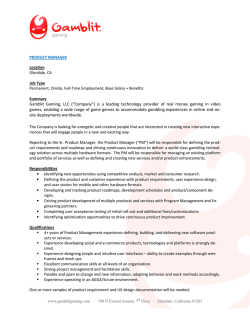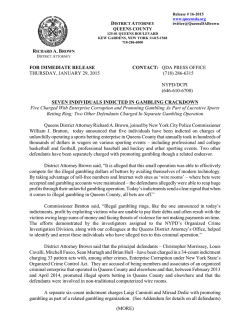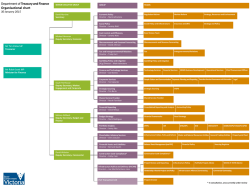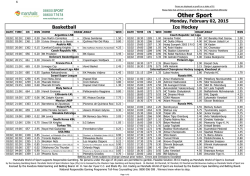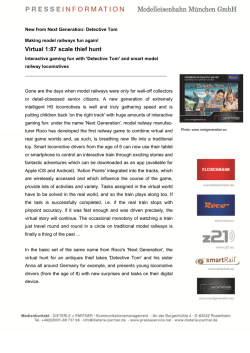
Social gaming - January 2015
Social gaming January 2015 1 Executive summary 1.1 This paper describes our area of interest in relation to social gaming, and the work we have undertaken to date. As we have made clear, our interest in social gaming has focused on those games that look and feel like traditional gambling games, but have no prize of money or money’s worth. 1.2 Following an initial assessment of the evidence we considered the risks to fall broadly into the following categories: • • • Problem gambling-type risks (people spending too much time and money) Transitional risks (increased participation in real money gambling, especially in relation to young people) Consumer protection-type risks (for example, people falling victim to scams). 1.3 Having received data from the social gaming industry we are now in a position to give a more considered assessment of the likely size and impact of the potential risks present in social gaming. 1.4 Based on the data we have seen, and subject to its limitations, we do not consider there is a persuasive case to move from the ‘watching brief’ stance we have adopted to date. While the data suggests that, in general, the vast majority of people who play social games spend very modest amounts of time and money, there is clearly a very small cohort who spend significant amounts. However, it is likely that this group is insufficiently large to justify any form of additional regulatory intervention. 1.5 While playing social games does not appear to be harmful in itself (for the vast majority) we are much less clear on whether it leads on to, or causes, more harmful behaviours. We are continuing to work with the Responsible Gambling Strategy Board (RGSB) to examine this issue. 2 Background – our area of interest 2.1 The social gambling market is growing rapidly with the introduction of ‘commercial’ gambling on social media. In addition, gambling companies have been buying games developers (like IGT’s purchase of Double Down) and social gaming companies are collaborating with regulated gambling businesses to offer real gambling (like Zynga’s deal with bwin.party). 2.2 A number of game developers are providing gambling-style games that look and feel like traditional gambling products. These games include online slot style games, poker, roulette or bingo and are offered on a variety of social network platforms (such as Facebook, Apple App Store, Google Play Store and BlackBerry App World) or directly via the developer’s website (eg Yazino). Victoria Square House Victoria Square Birmingham B2 4BP T 0121 230 6666 F 0121 230 6720 www.gamblingcommission.gov.uk Social gaming 2.3 These games may be free or paid to enter, for example, by paying for extra spins/credits/tokens/chips, but do not offer a cash prize. To date, it has been accepted that winning additional spins/credits/tokens/chips (that can also be acquired by the payment of real money) does not amount to a prize of money or money’s worth, which would make it licensable gambling. However, this is untested in the courts and the uncertainty, and associated commercial and regulatory risk, is a useful deterrent to those thinking of pushing the boundary. 2.4 Social gaming is used as shorthand to describe and encompass this diverse range of types of activity/platform. In some cases the label ‘social’ is a misnomer, as the social element need not be synchronous (playing simultaneously with friends), but may be asynchronous (playing the same game as friends, but not simultaneously, for example sharing achievements or high scores) or absent altogether (playing alone on a website). It should also be noted that the terminology ‘gaming’ is used in its everyday sense (the act of playing games), not the definition present in the Gambling Act 2005 (playing a game of chance for a prize). 2.5 We have always been clear that, for the moment, our interest is focused predominantly on gambling-style games (that look and feel like traditional gambling), ie games that would be licensable if there was a prize of money or money’s worth. 3 Background – what we have done 3.1 We have been and are closely monitoring developments to better understand whether there are aspects of the developing picture that pose risks to the public and, if there are, whether adequate protections in other consumer protection legislation are already in place. We have also been considering whether regulatory controls are necessary and have been working to ensure that we are in a position to provide advice to Government. 3.2 The potential risks are broadly considered to fall into problem gambling-type risks, transitional risks, and consumer exploitation risks. We would only want to advise government to bring social gaming within the scope of gambling regulation if we consider that these risks could not be addressed by: • • responsible self-regulation by operators targeted use of existing consumer protection powers for example, those of Competition & Markets Authority (formerly the Office of Fair Trading), Ofcom and the Advertising Standards Authority (ASA). 3.3 After completing some initial evidence gathering, including commissioning and publishing a review of what is known about the potential risks 1, we retained concerns about social gaming. However, we acknowledged that there could be some features of social gaming that help prevent these risks being realised. 3.4 We have worked with the social gaming industry (the industry), to build on our work by using their player data to further explore the size and potential impact of these risks. The initial focus of this work was through the International Social Games Association (ISGA), however, given their focus solely on very high-level aggregate data we subsequently engaged directly with individual providers of social games. 3.5 We have also formed the Social and Online Games: Regulators Information Group (SOGRIG) with other interested regulators. This group has been established to share knowledge, learning and research in relation to social gaming. Through this group we also ensure that we maintain an awareness of each others’ activities in this area, facilitate 1 Exploring social gambling; scoping classification and review (Gambling Lab, 2013). 2 Social gaming collaboration and joint working and ensure that there is no unnecessary duplication of effort in the work we undertake. The membership of this group is currently: • • • • • • • Ofcom Advertising Standards Authority Competition & Markets Authority PhonepayPlus Information Commissioner’s Office Video Standards Council HMRC (copy list member). 4 Potential risks 4.1 From our own assessment and scoping review we have identified and explored the following risks: • Problem gambling-type risks (ie similar harms to problem gambling): o People, especially young people, spending large amounts of time o People, especially young people, spending large amounts of money • Transitional risks - social gaming (through development of positive attitudes, normalisation, development of unrealistic expectations, exposure to advertising) increases: o Young people’s participation in real money gambling o Adult participation in real money gambling • Consumer protection-type risks (eg misleading information or scams). 4.2 While consumer protection considerations are clearly important, they are better managed by other organisations and are already covered by existing consumer legislation. We are working to improve our signposting on the consumer section of our website, so people with consumer protection concerns about social gaming know the appropriate body to contact. 5 Previous/external evidence Who plays? 5.1 It has been suggested, and often repeated by the social gaming industry, that the average social gamer is 40 years old and female 2. However, there is no such thing as an average social gamer. Particular genres/games are targeted at, and appeal to, different demographics 3; the age and gender profile of players varies significantly depending on the type of game. 5.2 Data obtained from Superdata (a provider of market intelligence on digital games) suggests that nearly half (48%) of players playing casino-style social games are aged 21-34 4. Again, this figure is unlikely to be universal – different platforms and game types will appeal to different demographics. 2 Casual Games Association & PopCap/ISG (p45 Social Gaming in Europe). Social Gaming in Europe. 4 NB; for unknown reasons, these demographic figures are only for players aged 21 and over. 3 3 Social gaming Who pays and how much? 5.3 Market reports have estimated that approximately 1-5% of players pay to play social games (for example, purchasing in game currency/tokens or virtual goods). A relatively small proportion of this sub-group (15%) accounts for an estimated 50% of all Freemium 5 revenues 6. To illustrate this with a hypothetical example, if a game had a total of 10,000 players, somewhere between 15 and 75 people would account for approximately half of the game’s total revenue. 5.4 Studies have suggested that the gambling genre of social games is among the best monetising apps, with an estimated 5-10 US Cents revenue per user 7. It should be noted this figure is so low because the number of total users also includes non-paying users (who are in the significant majority). General limitations of industry evidence 5.5 We are clear that a significant amount of the data on this issue is subject to a number of limitations: • • • • • • • Mean averages (which the social gaming industry often relies on) are largely meaningless without an indication of the standard deviation and/or a sense of the distribution. Similarly, it is beneficial to know absolute numbers and not just proportions (a small percentage of gamers may still be a sizeable group in absolute terms). In some circumstances there will be an element of double counting, a player playing across ten games will appear as ten players in some types of analysis. One weakness of looking at aggregate data is the absence of any inter-relation between variables. For example, an individual may be only playing one session per day (which would not appear problematic), but these sessions could be 12 hours long (which clearly is) or they could be moving from session to session on a different game on the same day. Similarly, a player may only play, for example, 2 minutes per day on a particular game, but this behaviour could be repeated across multiple games or game providers. In any player data there is inevitably a large cohort of unknowns – many games do not require the player to provide their age (and even when they do, there is no age verification). Data in market reports is often across all types of social game and does not separate out gambling-style games. Evidence of transition 5.6 There is a considerable amount of research which shows a correlation between free/practice games and real money gambling in young people. According to the last Young People Omnibus Survey (Ipsos MORI, 2014): “Iterations of [this] survey have consistently shown that gambling for money is closely associated with free or practice gambling.” 5.7 However, this relationship is not necessarily causal; it could simply be indicative of a fondness for risk-taking behaviour/gambling-type products generally, or that certain factors (individual and familial) underlie both activities (King et al 2014). 5 a business model, especially on the internet, whereby basic services are provided free of charge while more advanced features must be paid for Casual Games Association (2012) (p70 Social Gaming in Europe). 7 Social Gaming in Europe. 6 4 Social gaming It is also possible that any causality could be in the other direction - for some people, real money gambling could have led them to social gaming (not vice versa). 5.8 However, what we do know is that earlier exposure to gambling and an early experience of a ‘big win’ are risk factors for problem gambling later in life. The caveat here is we do not know the potential impact of an early big virtual win (presumably it replicates, to an extent, the buzz but obviously not the financial gain). 5.9 Emerging international research suggests that, in relation to young people, the most common exposure to gambling content occurs in video games (King et al 2014). This may be a standalone game (Hard Rock Casino, Sega Casino) or content within a wider game (eg in Grand Theft Auto your character can visit and play in a casino). This is an issue we will continue to explore with the Video Standards Council, who administer the PEGI (PanEuropean Game Information) scheme in the United Kingdom. 5.10 Due to ability of social games to have inflated payout rates (ie you can have a return to player in excess of 100% when there is no real money payout) there is clearly the potential for the development of unrealistic expectations in relation to gambling. This is especially significant when a game has a real money equivalent that looks very similar. The Remote gambling and software technical standards mean that free versions of games provided by Gambling Commission licensees must behave in the same way as their real money equivalents. However, there could be circumstances where real money and social gaming games are branded very similarly but operated by different companies or where there is a degree of separation between the two. The development of unrealistic expectations (eg that gambling is an easy way to make money) obviously has the potential to increase (a) gambling participation generally and (b) more harmful patterns of play for those that do gamble. Indeed, emerging research has already found that exposure to inflated return to player percentages in practice/demonstration modes can lead to short-term increases in risk-taking (Frahn, Delfabbro & King 2014). 5.11 We are aware that international research is due to be published (Professor Derevensky in Canada) looking into the issue of transition from social games into real money gambling, these pieces will feed into our thinking when they are available. How many young people are actually playing gambling-style games? 5.12 Although we are clear that transitional risks are also applicable to adults, it is the potential for gambling-style social games to encourage young people to gamble which dominates the public discourse. 5.13 Data from the Young People Omnibus 2014 suggests there is actually a continuous decline in the proportion of children playing one of the free/practice games on the internet (from 15% in 2011 to 10% in 2014). 5.14 A recent study commissioned by the IGSA, A snapshot of youth in the digital playground: Digsogames and Digsinos (Harvest Strategy, 2014), analysed real player data from five different gambling-style social games. This one-month summary covered four markets: the US, UK, EU and Australia, and contained over 12 million players. This analysis, which had a youth focus, found that only 0.74% (90,665) of players were under 18, and only 0.56% (505) of this group paid to play. This means that out of the total pool of players (12m), only 0.004% were paying under 18s. 5 Social gaming Are more young people gambling? 5.15 The Young People Omnibus 2014 (Ipsos MORI, 2014) found that 16% of 11 to 15-year olds had gambled in the past week, this was in line with previous findings and indicated that the drop in gambling since 2012 has been maintained. 5.16 It may be that it is simply too early to detect the impact of social games on real money gambling participation or that, while social gaming may not affect the overall rate of gambling participation, it may cause some people to gamble in more harmful ways. It is possible we have yet to see any evidence of this as the numbers of young people involved in social gaming (to any significant extent) is very small, and that any adverse effects would only become apparent over time. 6 Our industry evidence sources 6.1 In order to assess the size and impact of the potential risk factors in social gaming we needed an analysis of disaggregated data. Initially we looked to the ISGA for analysis of the data from its members, but its first submission was constrained by the difficulties it had in obtaining disaggregated data from members, who were concerned about commercial confidentiality. We therefore approached some major operators who had responded positively to our interest in their products, and obtained player data from two leading game providers. This was considered alongside supplementary data on apps. While clearly they too had legitimate concerns about commercial confidentiality we found them very responsive and constructive with a real interest in assisting us in interpreting the data. 6.2 In the next section the data we obtained is supplemented, where relevant, with data from the ISGA-commissioned research: A snapshot of youth in the digital playground: Digsogames and Digsinos (Harvest Strategy, 2014). While this research was conducted completely independently of our work, it too looked at real player data - see paragraph 5.14 of this paper for details. 7 What this evidence shows 7.1 Given the commercial sensitivity of the data we received, the key findings presented below are mainly given in the form of averages (which we usually caution against relying on). However, the selected findings below only illustrate what the more detailed data we have seen appeared to us to indicate. All the findings are subject to a variety of limitations (as outlined above), and are derived from data from multiple sources, across a number of platforms, and covering various timeframes. 7.2 Provided below is a high level summary for each of the main risk factors, accompanied by selected key findings. Time spent playing 7.3 Those that do not pay (the vast majority) spend very small amounts of time on a particular game. Those who do pay spend more time (as would be expected), with older age groups in particular spending significantly more minutes per day on average. Data suggests a small number of people are spending significant amounts of time. • • Average time spent playing is very small for those not paying to participate (the vast majority) especially those age groups up to 35. As would be expected, average minutes per day is higher for paying customers – but still fairly low for ages up to 45 (less than 7.5 means per day on average). 6 Social gaming • • Adults who paid to play spent approximately 1.09% of the total minutes in the month doing so 8. This is estimated (the data table is not provided) to equate to roughly 486 minutes, or 15-16 minutes per day. [ISGA] Adults playing for free appear to have played for an average of roughly (the data table is not provided) 60 minutes in the previous month. This equates to nearly two minutes per day. [ISGA] Time spent playing (young people) 7.4 Young people do not appear, on average, to be spending large amounts of time playing. • • • • On average, non-paying under 18s, and 18-25s spend a very small amount of time playing per day (less than two minutes). On an average day, the number of UK players under the age of 18 for two of the leading gambling-style games combined, was less than 1,000. The number of under 18s paying to play, on an average day, was comfortably in single figures (three). Under 18s who paid to play spent approximately 0.7% of the overall minutes in the month doing so9. This is estimated (the data table is not provided) to equate to roughly 312 minutes, or ten minutes per day. [ISGA] Under 18s playing for free appear to have played for an average of roughly (the data table is not provided) 20 minutes in the previous month. This equates to just over half a minute per day. [ISGA] Money spent playing 7.5 Most people appear to be spending very modest sums, but there is a very small group of people spending very significant amounts of money. • • • When average spend per day is multiplied up, only age groups 46 and older have an average yearly spend in excess of $1,000, on a leading casino-style game. Globally, on a leading gambling-style social game, more than 90% of customers never spend anything. Of the 10% that do spend something, 90% spent less than $500 in the preceding 12 months (and most who spend anything spend considerably less than this). For a leading gambling-style game, less than 120 people (in the UK) spent more than $1,000 in the preceding year. Money spent playing (young people) 7.6 Young people, on average, are spending very small sums playing gambling-style social games. • • For a leading casino-style game, the average spend per day for those under 18 is very small, and even when multiplied up, still equates to a small yearly spend. The standard deviation was much less for spend than is the case with time spent, indicating a smaller number at the extremes of expenditure (people more tightly concentrated around the mean). Data shows that older players are accounting for most of the spend on a leading casino-style social game. 8 Note the phrasing of this finding makes it unclear whether this calculation only includes a customer’s paid for play, and omits any free play they do in the period. Again, note the phrasing of this finding which makes it unclear whether this calculation only includes a customer’s paid for play, and omits any free play they do in the period. 9 7 Social gaming • • For those who spent money, average lifetime spends for customers under 18 are very small, and for the two games where data was provided, were less than $30. Paid play by youth 13 to 18 years constituted 0.07% of all expenditure (note: the data showed there were instances where consumers spend several times more than the average). [ISGA] Transitional risks 7.7 The data provided by the industry cannot be used to explore potential transitional risks present in social gaming – that is, whether it causes or leads on to other harmful behaviours. 8 Challenging the assumptions 8.1 This section provides an overview of some of the assumptions and arguments often advanced in the public discourse on gambling-style social games. These are presented here to stimulate discussion, and illustrate the complexity of the debate, rather than to propose definitive answers. This list is not exhaustive and some of the arguments advanced (when taken as a whole) are inherently contradictory. The assumption: Gambling-style games act as a ‘grooming’ device and gateway in to real money gambling, especially for young people. The games should be restricted to those people over 18. The counter-argument: It is possible that these games could represent ‘graduated exposure’ to real money gambling, and that social gaming is a way of exploring, or an outlet for, risk taking behaviour. It is arguable that social games allow young people to explore and get bored of gambling-type games (ie the novelty wears off) and are reflective of an attitude among young people that things on the internet are always free (ie ‘why would I pay to gamble, when I can just play these games for free?’). It is possible that age-restricting these products could inadvertently glamorise them. But.... The very important caveat here is that these games very rarely correspond to their real money equivalents (eg they have significantly inflated payout rates), meaning young people may only ever learn misleadingly positive lessons about gambling. The assumption: Social gaming is ‘safer’ than real money gambling. The counter-argument: In social gaming you can still spend money (and a great deal of time), and there is still the possibility of loss-chasing behaviour. In fact, it has been argued that social gaming is actually potentially more harmful than real money gambling as there are no: • restrictions on how a game must behave • requirements for social responsibility tools (eg limit setting, age restrictions, selfexclusion) • monetary payouts (in effect, everything that is staked is ‘lost’). The assumption: Social gaming is a potential relapse trigger for recovering problem gamblers. The counter-argument: Social gaming could be an outlet for problem gamblers to indulge in risk taking behaviour, in that they can get the buzz from a similar type of behaviour without the need to spend any money. 8 Social gaming The assumption: Social gaming is an ‘acquisition funnel’ with the convergence of social gaming and real money gambling being intended to convert players from social gaming into gambling. The counter-argument: this may have been the original intention on the part of some operators, but it is possible that the funnel is now the other way round – ie operators want to convert gamblers into social gamers (where there is no inconvenience of actually having to pay out anything). Anecdotally we have heard that, for real money gambling operators, social gaming is a way of keeping consumers engaged with their brand and products after they have spent the money they set aside for gambling. It is also possible that social gaming and real money gambling are distinct products with only some overlap of customers. The assumption: The social gaming industry will remain opposed to regulation. The counter-argument: it has been suggested that social gaming is in a similar space to internet gambling 10-15 years ago, in that initial objections to regulation will disappear if and when there are increased public ‘scandals’ and charge backs. If and when this occurs it has been argued that the social gaming industry will want to be regulated and legitimised. 9 Conclusions and next steps 9.1 We have looked at both research by the industry and conducted our own assessment based on data provided directly by two leading game providers. This was considered alongside supplementary data on apps. Having conducted this assessment, we are clear there is no compelling reason at the moment to impose additional regulation on the social gaming sector given that it is already subject to extensive consumer protection legislation. 9.2 We will continue to monitor the issue of social gaming and emerging evidence from a variety of sources, working in partnership with the industry and other regulators. This will enable the relevant regulators to continue to mitigate any potential risks from social gaming as they arise. 9.3 In particular, we will work with Responsible Gambling Strategy Board (RGSB) on longer term transitional-type risks to see whether, and in what circumstances, social gaming leads on to/causes harmful behaviours. Gambling Commission January 2015 Keeping gambling fair and safe for all For further information or to register your interest in the Commission please visit our website at: www.gamblingcommission.gov.uk Copies of this document are available in alternative formats on request. Victoria Square House • Victoria Square • Birmingham • B2 4BP T 0121 230 6666 • F 0121 230 6720 • E [email protected] INFO 15/05 9
© Copyright 2025
